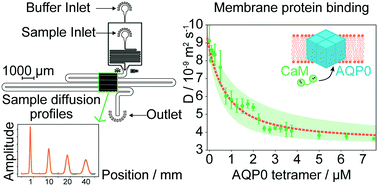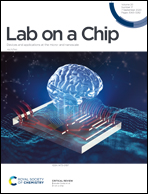A microfluidic strategy for the detection of membrane protein interactions†
Abstract
Membrane proteins perform a vast range of vital biological functions and are the gatekeepers for exchange of information and matter between the intracellular and extracellular environment. However, membrane protein interactions can be challenging to characterise in a quantitative manner due to the low solubility and large size of the membrane protein complex with associated lipid or detergent molecules. Here, we show that measurements of the changes in charge and diffusivity on the micron scale allow for non-disruptive studies of membrane protein interactions in solution. The approach presented here uses measurements of key physical properties of membrane proteins and their ligands to characterise the binding equilibrium parameters. We demonstrate this approach for human aquaporins (AQPs), key membrane proteins in the regulation of water homeostasis in cells. We perform quantitative measurements to characterise the interactions between two full-length AQP isoforms and the regulatory protein, calmodulin (CaM), and show that CaM selectively binds AQP0. Through direct measurements of the diffusivity and mobility in an external electric field, the diffusion coefficients and electrophoretic mobilities are determined for the individual components and the resulting AQP0–CaM complex. Furthermore, we obtain directly the binding equilibrium parameters and effective charge of each component. These results open up a route towards the use of microfluidics as a general platform in protein science and open up new possibilities for the characterisation of membrane protein interactions in solution.



 Please wait while we load your content...
Please wait while we load your content...